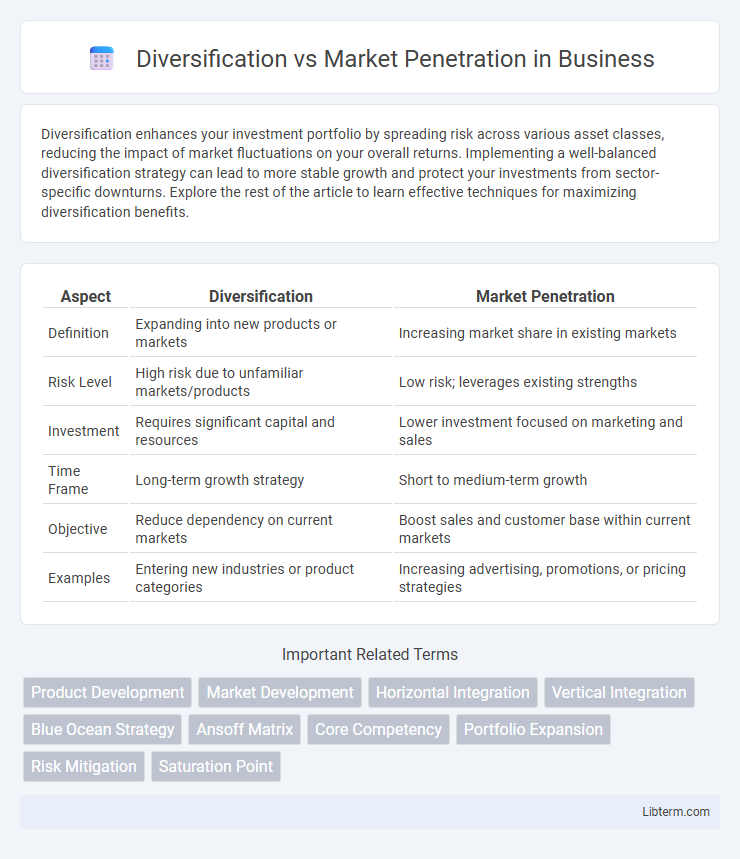Diversification enhances your investment portfolio by spreading risk across various asset classes, reducing the impact of market fluctuations on your overall returns. Implementing a well-balanced diversification strategy can lead to more stable growth and protect your investments from sector-specific downturns. Explore the rest of the article to learn effective techniques for maximizing diversification benefits.
Table of Comparison
| Aspect | Diversification | Market Penetration |
|---|---|---|
| Definition | Expanding into new products or markets | Increasing market share in existing markets |
| Risk Level | High risk due to unfamiliar markets/products | Low risk; leverages existing strengths |
| Investment | Requires significant capital and resources | Lower investment focused on marketing and sales |
| Time Frame | Long-term growth strategy | Short to medium-term growth |
| Objective | Reduce dependency on current markets | Boost sales and customer base within current markets |
| Examples | Entering new industries or product categories | Increasing advertising, promotions, or pricing strategies |
Introduction to Diversification and Market Penetration
Diversification involves expanding a company's product lines or markets to reduce risk and create new revenue streams, often entering unfamiliar industries or segments. Market penetration focuses on increasing sales of existing products within current markets by enhancing marketing efforts, adjusting pricing strategies, or improving product features. Both strategies aim to drive growth, but diversification emphasizes broadening business scope while market penetration concentrates on deepening market share.
Defining Diversification Strategy
Diversification strategy involves expanding a company's operations by adding new products, services, or markets that are distinct from its current offerings, aiming to reduce risk and enhance growth opportunities. This approach contrasts with market penetration, which focuses on increasing sales of existing products within current markets. Effective diversification requires thorough market research and resource allocation to successfully integrate new business areas without diluting the core brand.
Understanding Market Penetration Strategy
Market penetration strategy focuses on increasing sales of existing products within current markets by enhancing customer engagement and market share. Techniques include competitive pricing, aggressive promotion, and improved distribution channels to attract more customers and increase purchase frequency. This approach minimizes risk by leveraging familiar products and consumer bases while intensifying marketing efforts to outpace competitors.
Key Differences Between Diversification and Market Penetration
Diversification involves expanding into new markets or product lines to spread risk, while market penetration focuses on increasing sales within existing markets using current products. Diversification carries higher risk due to entering unfamiliar territory, whereas market penetration typically requires less investment and leverages existing customer bases. Companies adopt diversification for long-term growth opportunities, whereas market penetration aims for short-term revenue boosts by intensifying market share.
Benefits of Diversification in Business Growth
Diversification reduces business risk by spreading investments across different markets or products, enhancing overall stability. It opens new revenue streams, allowing companies to tap into emerging markets and customer segments. Diversification also fosters innovation by encouraging adaptation to varied consumer needs and competitive environments, which drives sustainable business growth.
Advantages of Market Penetration for Competitive Edge
Market penetration enhances competitive edge by increasing brand loyalty and customer base within existing markets, leading to higher sales volume and economies of scale. It allows businesses to leverage established distribution channels and marketing strategies, reducing costs and improving profit margins. Intensified market presence deters competitors and strengthens a company's position as a market leader.
Risks and Challenges of Diversification
Diversification carries significant risks including unfamiliar market entry, increased operational complexity, and high capital investment, which can strain resources and dilute core competencies. Companies face challenges in managing diverse product lines or services, integrating new business units, and aligning different corporate cultures. The uncertainty of success in non-core markets often leads to potential financial losses and reduced shareholder value compared to the more focused approach of market penetration.
Potential Drawbacks of Market Penetration
Market penetration strategies often face limitations such as market saturation, where further growth becomes challenging due to high competition and limited customer base expansion. This approach also risks price wars, which can erode profit margins and reduce brand value. Companies relying heavily on market penetration may neglect innovation and diversification, exposing them to vulnerabilities if market conditions shift.
Choosing the Right Growth Strategy: Factors to Consider
Choosing the right growth strategy between diversification and market penetration depends on factors such as market saturation, risk tolerance, and resource availability. Market penetration suits businesses aiming to increase market share within existing markets through competitive pricing and promotional efforts. Diversification involves entering new markets or developing new products, suitable for firms seeking long-term growth by spreading risk across different industries or customer segments.
Case Studies: Successful Examples of Diversification vs Market Penetration
Apple Inc. exemplifies successful diversification by expanding from personal computers into smartphones, wearables, and services, significantly increasing its market share and revenue streams. In contrast, Coca-Cola's market penetration strategy concentrated on intensifying sales of its core beverage products through aggressive marketing and distribution in existing markets, resulting in sustained brand dominance. Both strategies demonstrate how leveraging product innovation or deepening market focus drives competitive advantage and long-term growth.
Diversification Infographic

 libterm.com
libterm.com